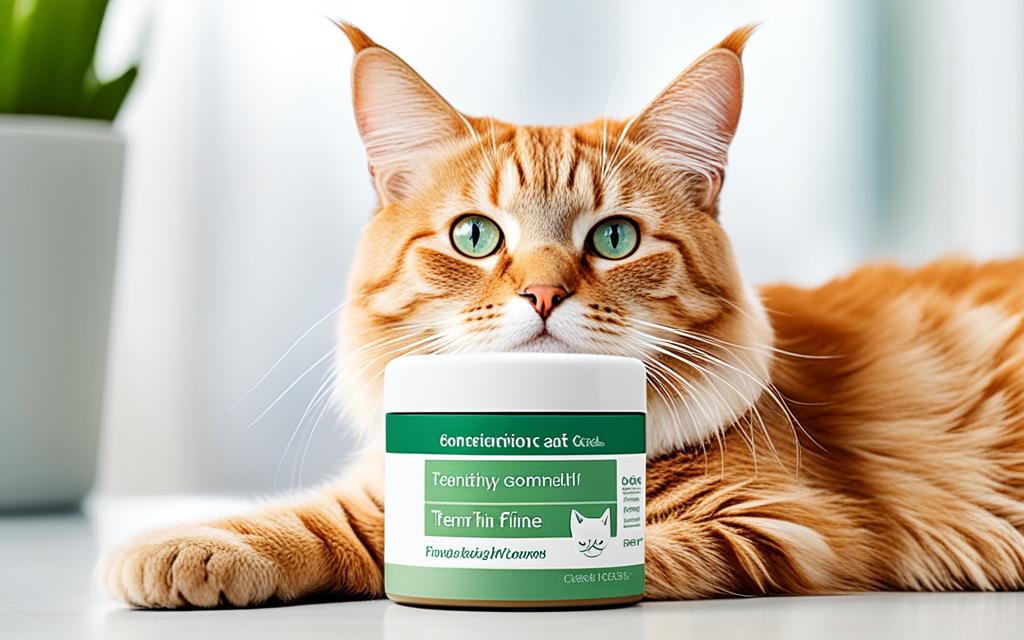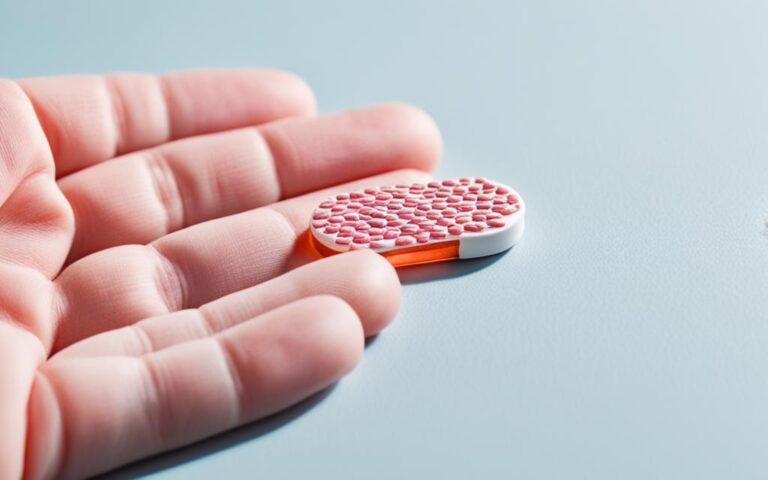Terbinafine for cats: Uses, Benefits, and Side Effects
Did you know as many as 40 types of dermatophyte fungi can infect cats1? It’s crucial to grasp how terbinafine, like Lamisil2, helps with these issues. This antifungal medicine is key in treating various infections in cats.
Key Takeaways
- Terbinafine is an effective antifungal medication used to treat fungal infections in cats.
- Common brand names of terbinafine include Lamisil and Terbinex2.
- Terbinafine can be used to treat fungal infections of the nails, skin, and other areas in cats.
- Potential side effects of terbinafine in cats include diarrhea, stomach upset, and liver damage3.
- Proper dosage, administration, and precautions are important when using terbinafine in cats.
Table of Contents
Introduction to Terbinafine for Cats
Terbinafine is a strong antifungal medicine for cats. It is very useful in treating specific fungal infections in these animals. It is part of a group of medicines called allylamine antifungals. They stop the fungi from growing by damaging their cell membrane45.
What is Terbinafine?
This is a man-made chemical that fights off fungal infections. It works well against dermatophytes such as Microsporum canis. Although it’s not specifically for pets, many vets use it for fungal problems in cats56.
Common Brand Names
Terbinafine goes by several brand names. The most popular ones are Lamisil and Terbinex. While they are mainly for humans, vets might recommend them for cats or give them as special compounds5.
Knowing about terbinafine and its brands helps owners understand their cat’s treatment for fungal issues. We’ll look into how this drug works, what it treats, and its side effects for cats456.
Understanding Terbinafine’s Mode of Action
Terbinafine is a strong antifungal medicine. It stops the production of ergosterol, which is vital for the fungal cell membrane7. This method makes terbinafine unique among antifungal drugs. It is very good at treating fungal infections in cats7.
Unlike some antifungal, terbinafine works differently. It stops the enzyme squalene epoxidase. This enzyme is important for making ergosterol7. By doing this, terbinafine affects the structure and function of the fungus. Eventually, the fungus dies. This makes terbinafine very effective against many fungal problems7.
Terbinafine is even more effective because of its good features for use in the body8. When taken by mouth, the body can use it very well, about 70% to 80% of it. It also stays in the body and keeps working for a long time, about 36 hours9. These things help terbinafine treat fungal infections in cats very well. It stays in the body long enough to combat the infection effectively.
The way terbinafine works and how the body uses it make it a key part of treating fungal diseases in cats7. Even as new antifungal medicines are created, the way terbinafine acts is still very important. It’s a big help in managing fungal issues in cats7.

In short, terbinafine interrupts ergosterol’s making, which breaks down the fungal cell and kills it7. Its special way of working and how the body handles it show that terbinafine is a great choice for fungal infections in cats89.
Uses and Benefits of Terbinafine for Cats
Treating Fungal Infections
Terbinafine treats tough fungal infections in cats well. It fights microsporosis, a common skin infection caused by the Microsporum canis fungus10. Studies show doses between 10-40 mg/kg daily work well10. This drug battles the fungus, fixing the infection and making the cat’s skin healthier.
Ringworm, a common name for these infections, affects many cats11. They’re usually from the Microsporum canis fungus. But other types like Microsporum gypseum and Trichophyton mentagrophytes can also cause issues11. Symptoms include hair loss, red skin, scaling, and crusts, all can really bother your cat11.
Terbinafine works great against Microsporum canis in cats10. Its strong antifungal powers help in many fungal problems in cats. This helps reduce irritation and stress from these infections.
Improving Cat’s Quality of Life
Terbinafine makes a big difference in a cat’s life by treating such fungal infections. Cat’s with these infections suffer a lot and aren’t happy. This could change how they act and feel11. By getting rid of the infection, terbinafine can make your cat much more comfortable and joyful.
Some breeds, like Persians and Himalayans, are more at risk of these infections11. For them, terbinafine is extra helpful. It cuts down on repeat infections, sparing both you and your cat from the worries these bring11.
The good effects of terbinafine are proven1011. It does a lot more than just fix the skin. By clearing up the infection, terbinafine also brings back your cat’s happiness. It makes their whole self feel better.
To wrap up, terbinafine is a great choice for fungal infections in cats. It boosts their quality of life and health101112.
Administering Terbinafine to Cats
Terbinafine is a strong antifungal drug used with cats. It’s given by mouth, as a tablet or liquid5. What amount and how often it’s given depend on the cat’s weight and the illness being treated5. Always follow the vet’s advice carefully to make sure your cat gets the right amount for the right time.
Dosage and Frequency
The usual amount of terbinafine for cat fungal infections is 10-20 mg/kg once each day for slight to moderate cases. For tougher infections, it might be 30-40 mg/kg daily13. The treatment usually lasts 4-6 weeks. But, treat until the infection is totally gone5.
Directions for Use
Terbinafine comes in many kinds, like 250 mg tablets and 1% gel for the skin. Vets might ask you to give it to your cat 1-3 times daily, depending on what fungus the cat has14.
It’s crucial to stick to the vet’s plan for how much and how often terbinafine is given. This avoids giving too much or too little. The wrong dose could make things worse or not better at all5.

“Terbinafine should be stored at a controlled room temperature of 68–77°F and protected from light exposure.”14
Knowing the right way to use terbinafine helps pet owners and vets improve how they treat cat fungal infections. This means a better life for the cat5.
Potential Side Effects and Precautions
Terbinafine is normally safe for cats but sometimes, it has side effects. These might include vomiting, not wanting to eat, or diarrhea. Terbinafine might also make cats pant a lot or have high liver enzyme levels.6 In rare cases, it can cause tiredness or make the face itchy.
Common Side Effects
- Diarrhea or upset stomach6
- Changes in how things taste or smell15
- Liver damage or allergies are rare but possible15
Precautions for Pregnant and Lactating Cats
If you have a pregnant or nursing cat, your vet might want to be extra careful when using terbinafine. Make sure your cat isn’t allergic to it. Also, if your cat has liver or kidney problems, terbinafine is not a good idea6.
Before starting, your cat should have a liver health check, and during treatment, regular liver function tests are needed.6
Keep the terbinafine tablets and granules at 77°F in a dry, dark place. The cream or spray also likes 77°F and should be tightly sealed and kept from light.616
Watching your cat closely and telling the vet about any issues is key. Knowing the possible risks and being careful makes terbinafine safer for your cat. It’s about being informed and taking steps to protect your pet61615.
Terbinafine for Cats: Uses, Benefits, and Side Effects
Terbinafine is a strong antifungal drug used to treat fungal infections in cats. It works by breaking down the structure of the fungi, getting rid of the infection2. This medication is often used for fungal nail infections. It stops conditions like onychomycosis, which can hurt the cat and lower its life quality.
Terbinafine is known for being very helpful for cats17. It’s mostly used for nail fungus from dermatophytes. The common dose is a 250 mg tablet each day. For fingernail fungus, it’s usually taken for 6 weeks. To treat toenail fungus, it’s taken for 12 weeks.
Cats usually handle terbinafine well. But it’s important to know about the possible side effects17. In studies, 1.7% had low white blood count more than once. Taste issues like loss were found in 2.8%. This was higher than the 0.7% in those who had fake pills.
Rarely, terbinafine can hurt the liver, even causing the need for a liver transplant or death. Depression and certain blood diseases can also happen while using terbinafine.
Cats with liver problems need extra care with terbinafine. Their owners should tell the vet about any bad reactions. It’s also essential to not share this drug with other pets.
Terbinafine can mix poorly with some other drugs. It might make cats more sun-sensitive. Vets could suggest preventing sunburn with clothes and sunblock.
In cases of severe side effects like allergies or liver issues, get medical help fast. Other common but less severe reactions include stomach problems and headaches.
Terbinafine is a key fungus-fighting drug for cats. It treats different fungal infections, like nail fungus. Knowing the possible side effects and following your vet’s advice is important when using terbinafine for your cat.
Comparing Terbinafine to Other Antifungal Medications
Treating fungal infections in cats, terbinafine stands out as a top choice. It works well and is economical. This makes it shine above other antifungal drugs.
Efficacy Comparison
Researchers found terbinafine to be very effective at fighting various fungal infections in cats. For example, a 2004 study tested two doses on sporotrichosis with great results18. Another study in 2002 showed terbinafine’s strength against certain fungi18. And in 2000, its effect was reconfirmed in a different study18. Evidence from a 1988 study also points toward its effectiveness18.
Cost Comparison
On top of working well, terbinafine might be more budget-friendly than other antifungals. The price varies, but general comparisons are helpful.
For instance, treating a 44-lb dog with ketoconazole daily costs about 50¢. Itraconazole, on the other hand, runs about $8 per day for the same dog. Terbinafine is often a more cost-effective choice. This makes it attractive for cat owners who need to watch their budget.
Deciding on a medication depends on the cat’s needs and the vet’s advice. Terbinafine’s strong performance and potential cost savings make it worth considering. Especially for those looking to treat fungal infections in their cats without breaking the bank.
Frequently Asked Questions About Terbinafine for Cats
Terbinafine is often used to fight fungal infections in cats. It’s a common topic of questions for pet owners. Here, we explain many common inquiries to give a full picture of this antifungal and its role in cat health.
How Much Does Terbinafine Cost for Cats?
Terbinafine can be very cost-effective for treating cats. It costs about $0.75 per tablet normally, and $0.72 per tablet with Autoship19. This makes it a good choice for those looking for a budget-friendly way to treat their cat’s fungal issues.
What Are the Side Effects of Terbinafine in Cats?
For cats taking Terbinafine, vomiting is the top side effect to look out for19. While not common, there can be serious effects like liver problems, skin issues, and bone marrow troubles20. Owners should watch their cats closely for any bad reactions and talk to their vet if they’re worried.
How Effective is Terbinafine for Treating Fungal Infections in Cats?
Reviews on Terbinafine for cats show mixed success in fighting fungus19. However, the drug seems to work well and is cost-effective against ringworm in cats19. It’s vital to use the medication as directed to get the best results without causing resistance to antifungals.
Can Terbinafine Interact with Other Medications?
Terbinafine might interact with some medications via the liver pathway20. Also, taking it with cimetidine can raise Terbinafine levels in the body20. It’s best to talk to your vet before giving Terbinafine and any other drugs to your cat, including common ones like antibiotics or Benadryl19.
What is the Recommended Dosage of Terbinafine for Cats?
The right amount of Terbinafine for cats depends on their weight and the issue being treated19. Usually, it is given 1-3 times a day, best if taken with food20. It’s really important to carefully follow the vet’s dosage and finish the treatment, for the best effect.
Are There Any Precautions for Using Terbinafine in Cats?
If a cat has kidney or liver problems, is pregnant, or nursing, don’t give them Terbinafine20. It should be kept in a cool, dark place20. Giving the pill to your cat may be hard because some cats don’t like swallowing pills well19.
In answering these typical questions, our goal is to help cat owners understand more about Terbinafine. We cover its uses, benefits, and possible challenges in treating fungal problems in their cats.
Conclusion
Terbinafine is an important antifungal medication for cats. It’s great for treating skin infections caused by a fungus called Microsporum canis21. Understanding how it works and its benefits helps pet owners and vets know the best way to use it.
We know a lot about these fungal infections thanks to data from reliable sources212223. This shows how key it is to quickly find and treat these infections. Managing the cat’s living environment is also crucial to stop the illness from coming back or spreading to people.
Terbinafine brings many pluses for cats, like being strong against fungus and targeting it well23. Learning the right way to give it, the proper dose, and its possible effects lets owners team up with their vet. This teamwork ensures the drug is used well in treating Terbinafine for cats and other antifungal medication for cats.
FAQ
What is terbinafine and how does it work as an antifungal medication for cats?
What types of fungal infections can terbinafine be used to treat in cats?
How is terbinafine typically administered to cats?
What are the potential side effects of terbinafine in cats?
How does terbinafine compare to other antifungal medications for cats?
Source Links
- Ringworm in cats | International Cat Care
- Terbinafine: Uses & Side Effects
- Lamisil Oral: Uses, Side Effects, Interactions, Pictures, Warnings & Dosing – WebMD
- Successful resolution of dermatophyte mycetoma following terbinafine treatment in two cats
- Terbinafine for Dogs and Cats
- Terbinafine – Oral | VCA Animal Hospitals
- A review of selected systemic antifungal drugs for use in dogs and cats
- New drug therapies in veterinary dermatology (Proceedings)
- Terbinafine – an overview | ScienceDirect Topics
- Terbinafine hydrochloride treatment of Microsporum canis experimentally-induced ringworm in cats
- Skin Fungal Infections in Cats
- Does terbinafine cream can use in cat? | 5 Answers from Research papers
- Drug efficacy of terbinafine hydrochloride (Lamisil) during oral treatment of cats, experimentally infected with Microsporum canis – PubMed
- Terbinafine (Lamisil)
- Terbinafine: Side Effects, Uses, Dosage, Interactions, Warnings
- Terbinafine – Topical | VCA Animal Hospitals
- Terbinafine: Package Insert – Drugs.com
- In Vitro Susceptibilities of Isolates of Sporothrix schenckii to Itraconazole and Terbinafine
- Terbinafine (Generic)
- Mar Vista Animal Medical Center
- Dermatophytoses in Dogs and Cats
- GUIDELINE for Dermatophytosis, ringworm in cats — ABCD cats & vets
- Pulse Therapy in Chronic Feline Dermatophytosis – WSAVA2009







